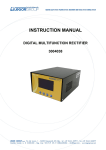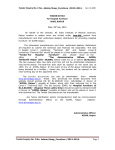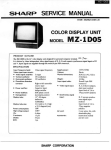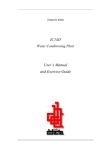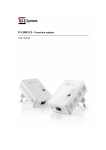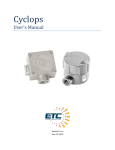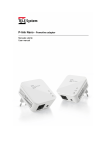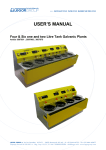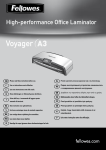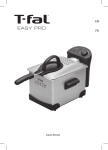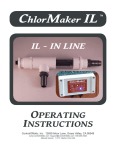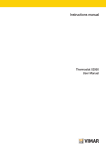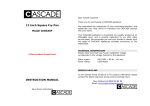Download USER S MANUAL
Transcript
USER S MANUAL Rectifier 1 10 A/10 48 V for Kliar Line Art. 3004052 Dichiarazione CE di Conformità CE Conformity Declaration TIPO DELLA MACCHINA: RADDRIZZATORE 1 PRODUCT TYPE: RECTIFIER 1 Modello/ Model 10 A/10 10 A/10 48 V PER KLIAR LINE 48 V FOR KLIAR LINE 3004052 Matricola/ Serial Number: Anno di costruzione/ Manufacture year Il sottoscritto Gianni Poliero Legale rappresentante dell azienda LEGOR GROUP Srl DICHIARA The undersigned Gianni Poliero, representative of LEGOR GROUP Srl legal DECLARES sotto la sua esclusiva responsabilità, che la macchina, a cui la presente dichiarazione si riferisce, è conforme alle prescrizioni delle: under his sole responsibility that the machine, to which this declaration relates, conforms to following standards: - 2006/95/CE, Direttiva Bassa tensione - Directive 2006/95/EC, on Low voltage equipment - 2004/108/CE, Direttiva Compatibilità elettromagnetica - Directive 2004/108/EC, on Electromagnetic compatibility - 2002/95/CE, Direttiva ROHS - Directive 2002/95/EC, on ROHS Bressanvido (Vicenza), LEGOR GROUP Srl Legale Rappresentante / Legal Representative Table of Contents: Chapter 1. General Description of the Machine 2. Operation & Control Stations 3. Protections and Safety Precautions 4. Important Machine Technical Data Card 5. Use of the Machine 6. Movement and Transportation of the Machine 7. Installation of the Machine 8. Assembly/Disassembly of the Machine 9. Set Up of the Machine 10. Commissioning of the Machine 11. Maintenance and Repair 12. Attached Technical Documentation 13. Information on Machine Noise Pollution CHAPTER 1 GENERAL DESCRIPTION OF THE MACHINE 1.1 OPERATING PRINCIPLES AND MAIN TECHNICAL CHARACTERISTICS LEGOR GROUP galvanising machines are built for the galvanisation of goldsmith objects, costume jewellery, watch-making pieces and precision mechanics. The objects to be galvanised are treated in the machines before being degreased and performing other jobs such as rhodium, gold, platinum or palladium plating. Degreasing is generally performed by placing the objects in the tank the furthest to the right on the machine, where there is a degreasing/pickling solution, whose action is activated by the passage of electric current. The other galvanic treatments, on the other hand, can be performed in the other tanks, by placing the objects in the electrolytic solutions and running the appropriate working current through them. The most important technical characteristics of our galvanising machines are: Digital instrumentation Programmable work timer 10 48 V / 25 A current rectifiers 110V available on request Modest weight and dimensions Totally made of stainless s NOTE: The process should develop vapours during operation, due to the electrolytic galvanisation; therefore they must be placed in a working environment equipped with an adequate suction hood 1.2 Machine architecture: 1.2.1 Introduction: The machines are made up of: A main body containing all of the machine parts. Anodic cable (red cord). Cathodic cable (black hook cord). Power cable. 1.2.2 Make up of the machine: A0) Machine Body. The machine body is made from stainless steel and contains all of the machine parts. The partitions are closed and tools are required to access the inside. The machine is installed on a flat surface and is made stable with four 2 cm feet. The body of the machine is made of stainless steel and has no cutting parts or sharp corners that are dangerous for the operator. A1) General description of the machine B) Anodic and Cathodic Electrodes. The machine is equipped with a red cable collected to the anode and a black cable collected to the cathode aside red and black clips. C) Power cable. The machine is equipped with a power cable with plugs for connection to the socket on the rear of the machine body and for connection to the mains, which must be present in the place where the machine is installed. 1.3 WARNINGS. It is necessary to read this manual carefully before proceeding with installation, commissioning, adjustment and maintenance of the machine. All of the operations described in this manual are correct, the manufacturer does not accept any responsibility for operations performed in a manner that is not in conformity with the instructions or operations not envisioned in this manual. In the event of breakdown or malfunction of the machine, apply to an authorized technical centre or to the manufacturer. The manufacturer declines any responsibility for damages to persons or property or accidents due to failure to observe the prescriptions relative to safety, due to improper use or tampering with the machine. The safety norms described in this manual integrate and do not supersede or replace the norms in force locally, which must be observed by users in any case. CHAPTER 2 OPERATION & CONTROL STATION 2.1 GENERAL The machine is used as a workstation. All controls to start and adjust the machine are located on the front panel in a convenient position for the operator. 2.2 SETTING UP THE WORK AND CONTROL STATION The machine must be placed on a flat surface to prevent the risk of turnover. On request, a suitable metallic platform may be provided to support the machine. The installation must be performed in a dry, well-aired and correctly illuminated environment. Additionally, there must be an appropriate water system near the place where the machine is installed to permit ultrasonic water flow connection and cleaning of the tanks. NOTE: The solutions should develop vapours during operation, due to the cataphoretic process, therefore it must be placed in a working environment equipped with an adequate suction hood. An appropriate disposal system MUST be provided for the drainage of the galvanic/ecoating solutions utilised, in harmony with the instructions supplied with the relative liquids. CHAPTER 3 PROTECTIONS AND SAFETY PRECAUTIONS OPERATORS AND MAINTENANCE PERSONNEL FOR The machine must not produce an average weighted noise A above 80 dB. The machine has NO rotating parts that could come into contact with the operator. The liquids used in the cataphoretic process are made in a low concentration chemicals; in any case the operator must wear appropriate Personal Protective Clothing (apron, gloves, goggles). The operator must read the instructions and prescriptions provided with the products utilized carefully. It is a good practice for the operator to refrain from smoking and eating or drinking near the machine. CHAPTER 4 IMPORTANT MACHINE TECHNICAL DATA CARD External dimensions mm (300 x 175 x 300) Weight kg 12.5 Power tension V 230 Vac single phase 50-60 Hz Adjustment of galvanic tension and distributable current V 10-48 V Timer m 90 minutes 25 A CHAPTER 5 MACHINE USE 5.1 INTENDED USE OF THE MACHINE. This machine was built for the cataphoretic (e-coating) treatment of goldsmith objects, costume jewellery, watchmaking pieces and precision mechanics. PRECAUTIONS: When the machine is operating the smoke suction and disposal system must be on (suction hood, which must be installed at the worksite). The operator must wear protective clothing, goggles and gloves and any other protective clothing envisioned on the technical cards of the components used for the galvanic baths; the machine must not be tampered with. Use only e-coating solutions supplied by the manufacturer. Do not place objects and/or excess liquid in the tanks, as this could cause dispersion of the corrosive toxic liquid. If this occurs, carefully follow the instructions shown on the technical cards accompanying the products used and, in any case, thoroughly clean the areas involved immediately. To clean surface areas where galvanic or e-coatings liquids have been spilled, the operator must wear appropriate individual protective clothing: (gloves, apron, goggles, protective mask for the respiratory system). Connect the machine to an electrical system in conformity with legal norms. Dispose of used galvanic or e-coating liquids in accordance with the indications shown on the relative technical cards for the solutions used. 5.2 CORRECT USE OF THE MACHINE The machine is used by operating the controls and in situations of emergency it can be stopped at any time, by turning the general power switch to the O position. NOTE: The solutions used for the e-coatings, plating, degreasing and neutralization must be purchased ready made in order to ensure safe and valid processing. Alternatively, the solutions can be prepared by the operator, in which case the instructions shown on the technical cards of the products used must be followed. Before placing the solutions in the respective tanks, they must be mixed. Place enough solution in the tanks to cover the electrodes. The solutions must be placed in the tanks when the machine is prepared and when they are exhausted they must be replaced. OPERATIONAL STEPS TO OBTAIN PERFECT FINAL RESULTS 1. Degreasing with ultrasounds 2. Rinsing in demineralised water 3. Electrolytic degreasing 4. Rinsing in demineralised water 5. Neutralisation/activation 6. Rinsing in demineralised water 7. E-coating treatment (with Kliar-Line products) 8. First recovery in demineralised water 9. Second recovery in demineralised water 10. Rinsing in demineralised water 11. Dip the items into the Rinse Aid solution 12. Dry on air for 5-30 mins 13. Cure the items in a furnace/oven at 120-150°C for 30 mins. 1) Initial preparation of objects to be treated. (Degrasing with ultrasonic system or by electrolytic process) The objects must be carefully washed using the integrated ultrasonic washing tank, and then rinsed (operational steps 1 and 2) 2) E-coating treatment Check to make sure the suction hood is operating. Lift the cover and ensure the machine is on by checking the general ON/OFF switch (1). Hang the object on the hook on the negative electrode (cathode) and immerge it in the e-coating bath. Adjust the tension with the potentiometer (4), verifying the value set on the digital voltmeter (2) on the panel. If the timer has been activated with the (5) switch, adjust it (6) to start the e-coating process. Once the process has terminated, go on to the successive phases of rinsing (operational steps 8, 9, 10, 11 and 12). Important note: Remove the objects from the e-coating solution before cutting off the tension in the bath. 3) Stop the processing cycle. Turn off the machine off with the general switch (1). 5.3 UNINTENDED USE OF THE MACHINE It is not reasonable to envision a different use of the machine than the one for which it was designed, of galvanic treatment. 5.4 INCORRECT USE OF THE MACHINE Operating the machine in a manner other than as specified in point 5.2 of Chapter 5 constitutes incorrect use. CHAPTER 6 MOVEMENT AND TRANSPORTATION OF THE MACHINE The machine has dimensions and a weight that permits simple movement using mechanical lifts. To transport the machine, place it in the original packaging or in other suitable packaging, with the parts in polystyrene foam; make sure the upper part of the machine is oriented towards the top when performing the transportation. Move the machine with a suitable lift for transportation. Load only the packed machine on the lift and do not place other objects on top of it, inasmuch as they could damage the machine or fall; do not load the machine on top of other objects because there could be a situation of precarious balance during transportation. Check to make sure that all machine parts are properly fixed and cannot move during transportation prior to starting transportation. CHAPTER 7 INSTALLATION OF THE MACHINE 7.1 GENERAL The machine may operate in conditions of safety and with the best results if it is correctly installed in the working environment. 7.2 MECHANICAL INSTALLATION The machine must rest on a perfectly flat surface, on a dry and clean surface. The machine may have the rear side against a wall, even if it is advisable to leave enough room around the machine, at least 1 m, in order to facilitate performance of all of the cleaning operations, without having to move the machine. Additionally, it is advisable to have a larger free area on the front side of the machine to facilitate the operator s work. The installation plan of the machine is shown in Annex I. 7.3. ELECTRICAL CONNECTION The machine must be connected to the mains for electrical power. The electrical system must be in compliance with safety norms in force and satisfy the requirements of noninflammability. Before electrical connection, it is necessary: Ensure that the information relative to the power line corresponds to the indications on the machine identification plaque and the electric panel, as well as with the data shown in Chapter 4 of this manual; Ensure that the power cables have a diameter of at least 2.5 mm2. Ensure that an automatic magneto-thermal switch is place up line from the electrical circuit socket and that the circuit has the ground connection correctly connected to the power socket, which must be of a suitable type for connection with the plug on the machine cable. Make sure the machine power is not on. To turn on the power plug the power cable into the plant socket. In the event of breakdown or malfunction, apply to qualified personnel. CHAPTER 8 ASSEMBLY/DISASSEMBLY OF THE MACHINE 8.1 INITIAL ASSEMBLY OF THE MACHINE The machine is supplied ready for operation. The only task to perform is to connect the electrodes with anodes and the items to be treated through the conductive clips. CHAPTER 9 PREPARATION OF THE MACHINE FOR COMMISSIONING 9.1 GENERAL The machine is supplied ready for operation. 9.2 CHECK FOR ANY DAMAGE THAT MAY HAVE BEEN SUSTAINED BY THE MACHINE. When the packaging is removed from the machine, carefully inspect every part to ensure that it has not been damaged during transportation. If damages are discovered, contact the carrier first, then the seller or the manufacturer. Also ensure that the machine has been received, complete with all of its parts. 9.3 REMOVAL OF BLOCKS The machine is delivered without blocked parts; therefore no removal of blocks is required. 9.4 CLEANING THE MACHINE Before commissioning the machine, clean it carefully, removing dust and any foreign substances. It is advisable for the operator to use gloves, goggles and to wear an apron when cleaning the machine. Use a soft cloth to clean the machine and, possibly, with plastic spatulas and tools in order to avoid streaking the tanks or other parts. 9.5 CONNECTION OF THE MACHINE TO THE ELECTRICITY NETWORK Ensure that the information relative to the power line corresponds to the indications on the machine identification plaque and the electric panel, as well as with the data shown in Chapter 4 of this manual. Before performing the connection, make sure the electrical components to be worked on are not powered. Plug the power cable into the socket on the side of the machine and in the socket provided in the working area. 9.7 ADJUSTMENT OF THE MACHINE The machine requires no preliminary adjustment in order to start operation. CHAPTER 10 COMMISSIONING OF THE MACHINE 10.1 COMMISSIONING OF THE MACHINE Adhere to the following instructions in order to commission the correctly installed machine: Position the differential switch located up line from the machine in the closed position. The operator must wear the individual protective devices foreseen for the work performed. He must then position himself in a manner to ensure perfect visibility and within easy reach of all signals and controls. 10.2 USE OF THE MACHINE Refer to paragraph 5.2 for instructions on the correct use of the machine. CHAPTER 11 MAINTENANCE AND REPAIR 11.1. MAINTENANCE General The machine requires no particular maintenance, except for cleaning the machine itself. The machine functions well only if the various parts are clean. Maintenance of electrical connections. The electric power cable must be checked periodically and replaced if it is not in good repair. Changing fuses. The machine is protected with a 5A 220V ca fuse. The fused is housed in a box in the mains socket placed on the side of the machine body. Follow these instructions to replace the fuse: Turn the machine of with the general power switch on O; Cut off the machine from the mains socket by disconnecting the power cable from the network socket and the socket on the rear of the machine. Open the door, remove the blown fuse, insert a new fuse and close the door. Connect the network cable to the machine and the network socket. Turn the power switch on and check the to make sure the green indicator light comes on. If the machine fails to function, apply to the seller or to the manufacturer. 11.2 REPAIRS The operator must not perform any repairs; in the event of breakdown, apply to the seller or manufacturer. CHAPTER 12 ATTACHED TECHNICAL DOCUMENTATION 12.1 LIST OF ATTACHED DOCUMENTS The following documents are attached to this publication and are an integral part of it. Annex I: Diagram of electrical circuit of the machine CHAPTER 13 INFORMATION ON MACHINE NOISE POLLUTION 13.1 IMPORTANT VALUES The average weighted A noise pollution is less than 70 dB. Annex I: Diagram of electrical circuit of the machine














